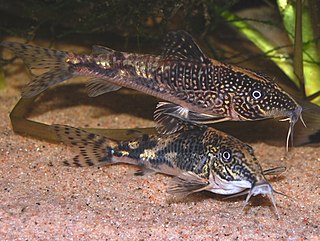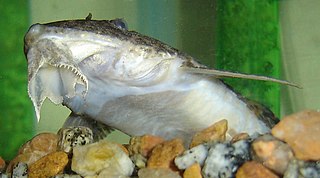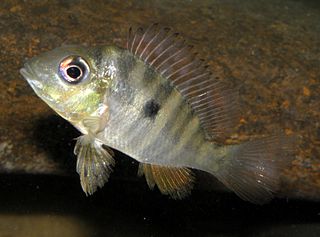
Callichthyidae is a family of catfishes, called armored catfishes due to the two rows of bony plates along the lengths of their bodies. It contains some of the most popular freshwater aquarium fish, such as many species in the genus Corydoras.

The banded corydoras or bearded catfish is a subtropical freshwater fish belonging to the Corydoradinae sub-family of the Callichthyidae family. It originates in coastal drainages in South America from Rio de Janeiro to Santa Catarina, Brazil.

The hog-nosed catfish is a tropical freshwater fish belonging to the Corydoradinae sub-family of the family Callichthyidae. It is native to South America, and is found in the western Amazon basin in Ecuador and Peru. This species is traditionally placed in Brochis but the genus is a synonym of Corydoras. FishBase continues to recognize Brochis as a valid genus.

Rineloricaria is a genus of freshwater tropical catfish belonging to the Loricariidae family. They are commonly called whiptail catfish because of the long filament that grows out of the tip of the caudal fin that is characteristic of the genus. With the exception of R. altipinnis from Panama, they are native to the rivers of northern and central South America. Some species are regularly seen in the aquarium trade.

Trichomycterus is a genus of fish in the family Trichomycteridae, the largest genus of its family with over 170 species currently described. This genus is native to freshwater habitats in Central and South America. These fish are generally small, usually about 5 to 15 cm (2–6 in) SL, although the largest, T. rivulatus, can reach more than twice this size. Species differ from one another primarily in body proportions, fin ray counts and colouration. Despite their relatively small size, some, such as T. punctulatus, support fisheries and are important in the local cuisine.

Gymnogeophagus is a genus of cichlid fishes from South America, where they are known from various river basins in southern Brazil, Paraguay, Uruguay and northern Argentina. They are part of a group popularly known as eartheaters.
Hemiancistrus is a genus of suckermouth armored catfishes. These species are native to South America. The taxonomy of this genus is complex and unclear, and major work has to be done. Many of these fish are popular aquarium fish.

The Hypoptopomatinae are a subfamily of catfishes of the family Loricariidae, composed of 17 genera and approximately 80 species. This subfamily represents about one-tenth of all loricariid species.
Pareiorhaphis is a genus of catfish in the family Loricariidae native to South America. This genus can be readily distinguished from other neoplecostomines by the unique combination of having fleshy lobes on lateral margins of head ornamented with hypertrophied odontodes on nuptial males, caudal peduncle ovoid in cross section, abdomen usually naked, dorsal fin spinelet ovoid and adipose fin usually present. The color pattern is usually dark brown and mottled with the abdomen white. Most species in to Pareiorhaphis were originally described in Hemipsilichthys. In 1918, Alípio de Miranda-Ribeiro proposed the new genus Pareiorhaphis. Whether Pareiorhaphis is monophyletic or not is currently unknown.
Neoplecostominae is a subfamily of South American catfishes of the family Loricariidae. Species of this subfamily live in high-mountain and swift-flowing river habitats.

Parotocinclus is a genus of fish in the family Loricariidae native to South America. This genus is distributed through almost all hydrographic systems in South America from the Guyana Shield drainages and Amazon Shield tributaries to the coastal drainages of eastern and southeastern Brazil, including the rio São Francisco basin. Most species have the caudal peduncle oval in cross section. It has been found that Characidium species may interact with P. maculicauda. The small Characidium will follow grazing P. maculicauda, which release particulate matter dislodged from the catfish's foraging.

Ituglanis is a genus of fish in the family Trichomycteridae native to South America. Their greatest diversity seems to occur in the Amazon River basin. Most species inhabit leaf litter, with several species living in caves.
Scleromystax salmacis is a species of catfish of the family Callichthyidae. S. salmacis has the southernmost distribution of its genus. It is known from the Mampituba River and Araranguá River basins in southern Santa Catarina State of Brazil, and the Ratones River, a small coastal river drainage in Florianópolis.
Trichomycterus balios is a species of pencil catfish endemic to Brazil, where it occurs in the upper portion of the Das Antas and Caí river basins, and the Mampituba river basin, in the state of Rio Grande do Sul. This species reaches a maximum length of 10.1 centimetres (4.0 in) SL.
Trichomycterus brachykechenos is a species of pencil catfish endemic to Brazil, where it occurs in the dos Sinos river, part of the Laguna dos Patos system, in the state of Rio Grande do Sul. This species reaches a maximum length of 7.1 centimetres (2.8 in) SL.
Trichomycterus diatropoporos is a species of pencil catfish endemic to Brazil, where it occurs in the da Prata and Turvo river basins, tributaries of the das Antas river, in the Laguna dos Patos system in the state of Rio Grande do Sul. This species reaches a maximum length of 6.8 centimetres (2.7 in) SL.
Trichomycterus poikilos is a species of pencil catfish endemic to Brazil, where it occurs in the Jacuí, Pardo and Taquari-das Antas river basins, tributaries of the Laguna dos Patos system, in the state of Rio Grande do Sul. This species reaches a maximum length of 9.25 centimetres (3.64 in) SL.















